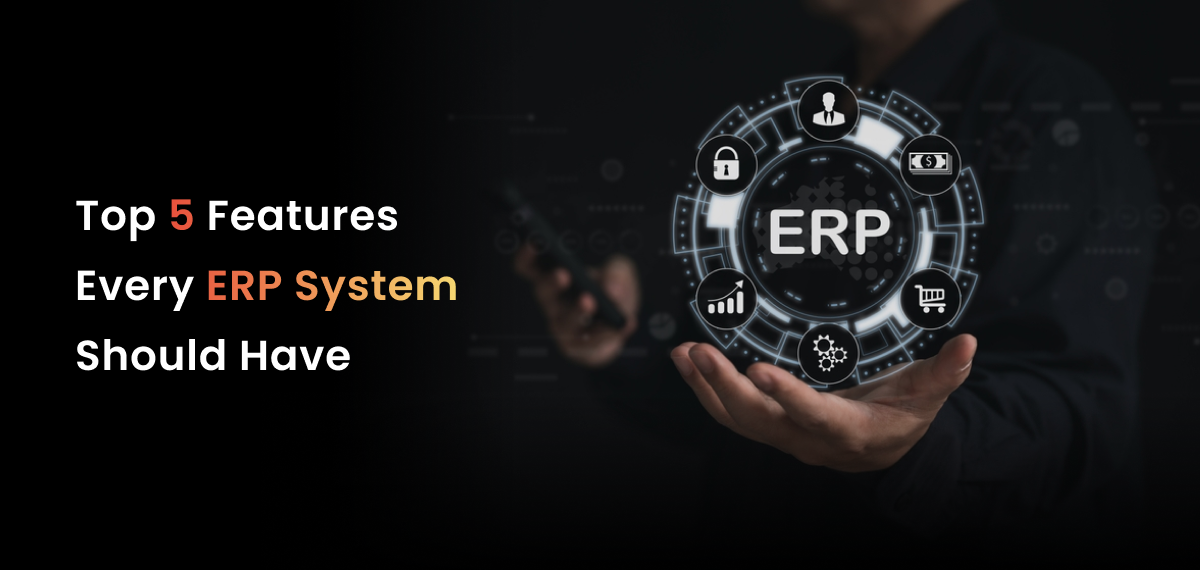Engagement Module
Next Gen AI Solution
Maintenance
Designing
Consultant
Industries
Top 5 Features Every ERP System Should Have

For organizations wishing to optimize their operations and improve effectiveness, they are vital. A good ERP system consolidates disparate tasks into one coherent system, offering
managers a chance to view and direct activities as they take place. The following are the five most important characteristics that should be found in every ERP system.
1. Comprehensive Financial Management
Any ERP system’s backbone is financial management. It helps companies operate accurately, legally, and effectively.
Key Components
- General Ledger: This is the major storehouse of all financial transactions, summarizing all accounting data for a complete understanding of how well the organization is doing financially.
- Accounts Payable and Receivable: These modules enhance the management of receipts and payments by streamlining management tasks thereby reducing mistakes made by people resulting in cash flow governance
- Budget Planning and Forecasting Tools: they enable corporations to set up budgets according to expected income reports from previous years among others
Benefits
- Improved precision of finances as well as conformity with regulation requirements.
- Increased capacity to direct and regulate financial processes.
- Improved financial planning and prediction potentialities.
- Informatization of finance allows for quick decisions based on real-time availability
about what’s going on in the field.
2. Supply Chain Management
SCM (Supply Chain Management) is key in making sure everything goes smoothly when products are produced and supplied at the right time while also being affordable. Various supply chain processes have been integrated and automated through the SCM module found in an ERP system.
Key Components
- Inventory Management: This keeps records of stock levels, orders, sales and deliveries so that firms can maintain optimal stock levels.
- Procurement: Whose responsibility is to acquire goods and services from suppliers thus ensuring that they are purchased on time at reasonable prices.
- Order Management: This streamlines the order-to-cash cycle starting from order entry all through to fulfilment and ensures it is accurate and satisfactory to
customers. - Warehouse Management: Focused on optimizing warehouse operations such as storing, picking, packing, and shipping hence a more efficient as well cost-effective
manner. - Logistics and Distribution: This entails managing transportation across places for fast delivery with less shipping costs.
Benefits
- Lowered inventory costs with enhanced accuracy of stock levels.
- Streamlined procurement process including ordering.
- Increased efficiency in warehousing and logistics leading to reduced delivery times.
3. Human Resources Management
Human resources (HR) is an essential aspect of every organization. An HR module of an ERP system assists in handling personnel data, payment of wages, hiring, performance evaluation, and other related functions.
Key Components
- Management of Employee Information: This centralizes info about employees
such as personal data, work experience and job descriptions which can easily be
accessed. - Management of Payroll: This system makes calculations on salaries and distributes
them across the board ensuring that no mistakes are made while adhering to
government tax policies. - Recruitment and Onboarding: This one-stop shop for hiring anyone from a posting
to a new worker who has just finished their training. - Performance Management: Keeping tabs on employee achievement setting targets
and carrying out assessments so that there can be development at all times. - Training and Development: This tracks development progress to promote improvement in skills and productivity.
Benefits
- Centralized staff information that is available from a single point.
- Pay cheque processing is automated thus ensuring accuracy when it comes to calculations.
- The recruitment process takes place efficiently without wasting time through back-and-forth movement between departments within the organization.
- Enhanced monitoring of employee performance as well as training provisions offered.
- Regulatory requirements are made better concerning Labor Laws.
4. Customer Relationship Management
It is an integrated module that is part of an ERP that helps firms to better meet their customer expectations as well as retain them.
Key Components
- Contact Management: Keeps thorough records of interactions with customers such as contact information, communication history, preference, etc.
- Sales Management: Supervises the entire selling procedure from generating leads to closing sales enabling the sales team’s organization (Rogan et al., 2019).
- Customer Service and Support: Provides tools for managing client queries, grievances, and tickets ensuring they are resolved effectively and timely.
- Marketing Automation: Manages all aspects of marketing including email campaigns, social media marketing or lead nurturing that aim at engaging prospects.
- Customer Analytics: Analyzes information about clients to identify emerging trends around their behaviors/preferences enabling data-driven decision-making.
Benefits
- Better handling of relationships with clients thus improving their satisfaction levels
- Enhanced sales and marketing streamlining
- Heavier focus on timely and efficient customer service
- More comprehension of the desires/needs of customers
- Increased retention hence loyalty towards us
5. Business Intelligence and Reporting
The actionable insights derive from data, which can only be achieved through Business Intelligence (BI) and reporting capabilities. Moreover, an ERP system that supports BI helps organizations examine their data, observe performance indicators, and consequently make better choices.
Key Components
- Data warehousing: This process involves collecting data from different sources into one location for easy access by everyone. This ensures accurate and consistent
information within the organization. - Dashboards and Visualizations: This provides interactive dashboards and visualizations to present data in an easily understandable format.
- Reporting: This generates detailed reports on various aspects of the business, including financial performance, sales, and operations
- Predictive Analytics: Uses historical data to predict future trends and outcomes through statistical algorithms.
- Key Performance Indicators (KPIs): KPIs are measured/ tracked to observe business performances so that improvement areas can be identified
Benefits
- Improved data accuracy and consistency.
- Enhanced ability for monitoring and analyzing business performance.
- Better decision-making based on real-time data insights.
- Identification of trends as well as growth opportunities.
- More responsiveness to changes in the market situation.
Conclusion
Incorporating an ERP system with these five key functions can tremendously increase a firm’s productivity, efficiency as well as decision-making capacities. A comprehensive financial management assures precise and compliant financial transactions whereas a supply chain management system smoothens production and delivery of goods.
Human resources management facilitates the development of employee information systems and enhances their productivity levels; customer relationship management leads to improved client satisfaction and loyalty. Lastly, business intelligence as well as reporting equip the firm with the information required for making the right decisions and sustaining growth.
Unifying these functionalities into a single ERP solution allows organizations to attain higher operation efficiency which is necessary for preserving competitive advantage in the marketplace.



